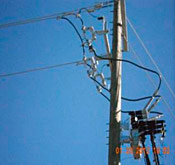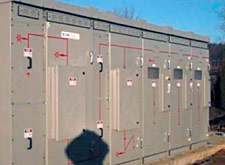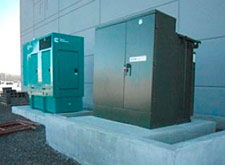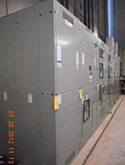Introduction
Within This Page
During the last century and a half, electricity has evolved from a scientific curiosity, to a luxury for wealthy people and to a daily necessity in the developed and developing world. Just as water is necessary for survival, electricity is indispensable in daily life. Without electricity, our way of life comes to a grinding halt. Modern society requires smart, simple, safe, reliable, and economical electric power infrastructure for social, political, and economic activities. The infrastructure should be efficient, flexible to expand, economical to maintain and operate.
A Brief History
- Electricity was never invented: its properties were discovered, examined, and explained.
- Thales of Miletus a Greek in 600 AD wrote of static electricity that attracted pieces of straw and hair to rubbed rods of amber. In 1752, during a dangerous electrical storm, Benjamin Franklin flew a kite that had a metal key at the bottom of the string. When a bolt of lightning hit the kite, a spark of electricity flew from the key. From this experiment, Franklin invented the lightning rod, which attracts lightning and draws it into the ground. This saves many buildings from burning down. In 1779 Alessandro Volta invented the first source of continuous electric current in his experiments with non-static electricity. He created a battery out of stacks of zinc and copper, with weak acids in between each layer.
- In 1769 James Watt, a Scottish Engineer transformed the limited use steam engine into a mega power source and radically transformed the world from an agricultural society into an industrial one. In his honor, a unit of electric power was named "Watts".
- Ampere (Amp), a unit of electric current named after André-Marie Ampère (1775-1836), French mathematician and physicist, is considered the father of electrodynamics.
- The first practical application of electricity was the telegraph, invented by Samuel F.B. Morse in 1837. The need for electrical engineers was not felt until some 40 years later, upon the invention of the telephone (1876) by Alexander Graham Bell and of the incandescent lamp (1878) by Thomas A. Edison. These devices, and Edison's first central generating plant in New York City (1882), created a large demand for men trained to work with electricity.
- Electrical Engineering covers power, electronics, control systems, signal processing and telecommunications field.
In engineering practice, the distinction between electrical engineering and electronics is based on the comparative strength of the electric currents used. In this sense, electrical engineering is the branch dealing with "heavy current"—that is, electric light and power systems and apparatuses—whereas electronics engineering deals with such "light current" applications as wire and radio communication, the stored-program electronic computer, radar, and automatic control systems.
The distinction between the fields has become less sharp with technical progress. For example, in the high-voltage transmission of electric power, large arrays of electronic devices are used to convert transmission-line current at power levels in the tens of megawatts. Moreover, in the regulation and control of interconnected power systems, electronic computers are used to compute requirements much more rapidly and accurately than is possible by manual methods.
The rapid proliferation of new discoveries, products, and markets in the electrical and electronics industries has made it difficult for workers in the field to maintain the range of skills required to manage their activities. Consulting engineers, specializing in new fields, are employed to study and recommend courses of action.
In the United States, the regulation of licensed professional engineers is handled at the state level. Thus, requirements for licensure can and do vary by state. The basis for most of the state legislation however is the National Council of Examiners for Engineering and Surveying (NCEES) Model Law.
There are four main components of obtaining professional engineering licensure:
- Education
- Fundamentals of Engineering (FE) Exam
- Work Experience
- Principles and Practice of Engineering (PE) Exam
Electrical engineering has many sub-disciplines, the most popular of which are high Voltage engineering (Power Companies), power engineering (Facilities), and power electronics. Although there are electrical engineers who focus exclusively on one of these sub-disciplines, many deal with a combination of them. Sometimes certain fields, such as electronic engineering and computer engineering, are considered separate disciplines in their own right.
Power engineering deals with the generation, transmission, and distribution of electricity as well as the design of a range of related devices. These include transformers, electric generators, and electric motors. Power engineers may work on the design and maintenance of the power grid as well as the power systems that connect to it. Such systems are called on-grid power systems and may supply the grid with additional power, draw power from the grid, or do both. Power engineers may also work on systems that do not connect to the grid, called off-grid power systems, which in some cases are preferable to on-grid systems. The future includes Satellite controlled power systems, with feedback in real time to prevent power surges and prevent blackouts.
Description
Electrical Engineering is the branch of engineering that deals with the technology of electricity, especially the specification and design of electrical systems and equipment for power generation and distribution, control, and communications. An electrical engineer who has a certifiable bachelor's degree in electrical engineering from a recognized School or University and satisfies the requirements for Engineer In Training (EIT) and Professional Engineer (PE) examinations and experience can apply for the state PE license. Once state registered, an Engineer by law has a primary duty to protect the public safety, health, and welfare in the facility electrical systems design by following and applying the latest building codes.
The Engineer of Record for the Electrical Systems Design is a state Registered Professional Engineer who develops the electrical system design criteria, performs the analysis, and is responsible for the design, specification, preparation, and delivery of the electrical documents for the construction of projects. Projects may include private /public works, institutional, commercial facilities such as banks, office buildings, schools and colleges, hospitals, medical clinics, retail stores, parking ramps, airports, manufacturing facilities, food distribution centers, warehouses, data centers, department stores, jails, libraries, theaters, and courthouses etc.
An Electrical System is any system and assembly of electrical components, materials, utilities, equipment, work system, machines, products, or devices which require electrical energy in order to perform their intended function.
Electrical Engineering Documents: The electrical drawings, specifications, reports and other documents setting forth the overall design and requirements for the construction, alteration, modernization, repair, demolition, arrangement, and/or use of the electrical system, or analysis or recommendations, as prepared by the Engineer of Record for the Electrical System.
Electrical Component: An individual electrical device to be part of an electrical system.
Electrical: Any device or mechanism that operates due to the action of electricity.
Electrical Submittals: Submittals, catalog information on standard products, or drawings prepared solely to serve as a guide for fabrication and installation and requiring no engineering input.
Codes and Standards: Those nationally recognized Codes and Standards adopted directly or by reference.
To specify and design facility electrical systems including power systems, lighting, communications, alarm systems, lightning protection, grounding system and controls, an electrical engineer needs to coordinate his effort with the fellow designers: Architect, Civil Engineer, Structural Engineer, HVAC/Plumbing Engineer, Fire Protection Engineer, Voice/Data low voltage technology, Building Security, Vertical Transportation, Electric Utility, Telephone Company, and Internet Access etc.
Power Systems Design
- Power systems distribute electrical energy. Major factors to be included in the design and analysis of these systems are: proper voltage levels, balances and quality, system capacity, reliability and redundancy, steady state and transient loads, short circuit protection (design and analysis), load flow, voltage drop, harmonics, and protective device coordination. The power systems design shall meet the local building codes, National Electrical Code (NEC), National Electrical Safety Code (NESC), and other applicable codes and standards.



Photos 1A, 1B and 2 (left to right): Utility service
- Electrical engineering documents applicable to power systems shall at a minimum indicate the following:
- Electrical legend
- System one line diagram or Riser Diagram
- Conductor capacities (sizes) and insulation type
- Protection devices and interrupting capability (Refer to Photo-2)
- Utility Service (Refer to Photo 1A-B)
- Transformer (Refer to Photo-3)
- Main and distribution panel board locations and sizes (Refer to Photo-4)
- Circuitry of all outlets and devices
- Short circuit analysis
- Load computations
- Grounding and bonding
- Low Voltage control diagrams
- Schedules and details


Photo 3 (left): Transformer; Photo 4 (right): Electrical Room
Lighting Systems Design
- Lighting systems convert electrical energy into light. Items to be included in the lighting design and analysis are: average illuminance, equivalent spherical illuminance, uniformity ratios, visual comfort probability, special purpose lighting, and the requirements of the local, state, and federal and ASHRAE 90.1 Energy Efficiency standards, and building Codes.
- Electrical engineering documents for lighting systems shall, at a minimum, indicate the following:
- Lighting fixture performance specifications and arrangements
- Emergency Lighting
- Exit Lighting
- Lighting Control and circuiting
Communications Systems Design
- Communications systems are utilized to convey messages or data. Items to be included in the design or analysis of these systems are: Human factors engineering, cabling requirements, installation requirements, performance requirements, backup power requirements, the interrelationship of the various systems, and applicable regulatory requirements.
- Electrical engineering documents for communications systems shall, at a minimum, indicate the following:
- System riser diagram
- Equipment legend
- Conductor type and installation requirements
- Device type and locations
- Backup power sources where applicable
Alarm Systems Design
- Alarm systems are used to monitor and alarm a fire or other emergency condition. Items to be included in the design or analysis of these systems are: structure alarm requirements, location and audibility, types of alarms and initiation devices, notification requirements, installation requirements and backup power requirements.
- Design documents for alarm systems shall, at a minimum, indicate the following:
- System riser diagram
- Device types and locations
- Type of conductors and installation requirements including rating identification and listing requirements
- Notification requirements
- Backup power requirements
Lightning Protection Systems Design
- Lightning Protection Systems are passive systems used to protect building and structures from damage caused by lightning and static discharges. Items to be considered in the design or analysis of this system include the requirements of NFPA 780.
- Electrical engineering documents for lightning protection systems shall indicate:
- Air terminals height and spacing
- Arrangement of Main and Down conductors
- Grounding points and spacing
- Legend
- Testing requirements of grounds
Grounding Systems Design
- Grounding Systems are passive systems used to establish an electrical potential reference point in an electrical system for the proper dissipation of energy in case of abnormal or transient conditions.
- Design documents for grounding systems shall indicate at a minimum the following:
- type and location of grounding electrodes
- bonding requirements
- testing requirements
- conductor material type, size and protection requirements
- separate grounding systems, properly bonded, per code and use requirements
Instrumentation and Control Systems Design
- Instrumentation and control systems are used to automate processes. Items to be included in the design and analysis of these systems are: reliability of control of critical processes, safety of personnel, and suitability of instruments and control devices in the environment in which they are installed.
- Electrical engineering documents for instrumentation and control systems shall indicate, at a minimum, the following:
- A description of the control system functions, or a functional diagram
- Specifications of control instruments and their location
- Type of conductors and cables, and requirements for their installation
Emerging Issues
- Quality Assurance and Control of Construction Documents
- Standardization, integration and promulgation of smart grid technology, smart power distribution system, smart metering, smart peak load demand controls, smart building management systems etc.
- Building commissioning or Integrated systems testing for building electrical, HVAC, all motor equipment and control systems.
- Energy Conservation
- Renewable Energy
- Energy Efficiency
- Emerging 3-D modeling platforms: BIM-Revit and Bentley
- Coordination of design documents with: Architects, Interior Designer, Lighting Design, Structural Engineering, Civil Engineering, Mechanical Engineering, Low Voltage Technology
Relevant Codes and Standards
- Telecommunications Industry Association
- Department of Defense
- AFM 32-1084 Facility Requirements
- ER 1105-2-100 Planning Guidance Notebook
- MIL-HDBK-419A Volume 1: Grounding, Bonding, and Shielding for Electronic Equipment and Facilities
- MIL-HDBK-419A Volume 2: Grounding, Bonding, and Shielding for Electronic Equipment and Facilities
- Technical Guide for Installation Information Infrastructure Architecture (I3A)
- TM 5-683/MO-116/AFJMAN 32-1083 Electrical Interior Facilities
- UFC 3-501-01 Electrical Engineering
- UFC 3-580-01 Telecommunications Building Cabling Systems Planning and Design
- UFC 3-580-10 Navy and Marine Corps Intranet (NMCI) Standard Construction Practices
- National Fire Protection Association (NFPA)
- NFPA 70: National Electrical Code
- NFPA 70E: Standard for Electrical Safety in the Workplace
- NFPA 780: Standard for the Installation of Lightning Protection Systems
- NFPA 90A: Standard for the Installation of Air Conditioning and Ventilating Systems
- NFPA 101: Life Safety Code
- NFPA 900: Building Energy Code
- NFPA 5000: Building Construction and Safety Code
- International Code Council
- Institute of Electrical and Electronics Engineers (IEEE)
Additional Resources
WBDG
Building Types/Space Types
Applicable to all building types and space types.
Design Objectives
Aesthetics, Cost-Effective, Functional / Operational, Productive, Secure / Safe, Sustainable
Products and Systems
Building Envelope Design Guide and Unified Facility Guide Specifications (UFGS)
Project Management
Professional Associations/Organization
- AABC Commissioning Group (ACG)
- Acoustical Society of America (ASA)
- Air-Conditioning and Refrigeration Institute (ARI)
- The American Institute of Architects (AIA)
- American National Standards Institute (ANSI)
- American Society of Heating, Refrigerating and Air-Conditioning Engineers, Inc. (ASHRAE)
- American Society of Mechanical Engineers (ASME)
- American Society for Testing and Materials (ASTM)
- Association of Energy Engineers (AEE)
- Building Owners and Managers Association (BOMA)
- California Commissioning Collaborative (CCC)
- Construction Specifications Institute (CSI)
- Electric Power Research Institute (EPRI)
- Electrical Testing Laboratories, Inc. (ETL)
- Institute of Electrical and Electronics Engineers (IEEE)
- Illuminating Engineering Society (IES)
- Instrument Society of America (ISA)
- International Code Council (ICC)
- International Organization for Standardization (ISO)
- National Fire Protection Association (NFPA)
- National Institute of Building Sciences (NIBS)
- National Electrical Manufacturers Association (NEMA)
- Underwriters Laboratories Inc. (UL)
- U.S. Green Building Council (USGBC)
Government
- Energy Information Administration (EIA)
- Lawrence Berkeley National Laboratory (LBNL)
- National Institute of Standards and Technology (NIST)
- National Renewable Energy Laboratory (NREL)
- Oak Ridge National Laboratory (ORNL)
- Pacific Northwest National Laboratory (PNNL)
- Sandia National Laboratories (SNL)
- U.S. Department of Energy (DOE) – Energy Efficiency and Renewable Energy (EERE)
- Building Technologies Program
- Distributed Energy Program
- Federal Energy Management Program
- Geothermal Technologies Program
- Hydrogen, Fuel Cells & Infrastructure Program
- Industrial Technologies Program
- Solar Energy Technologies Program
- Wind & Hydropower Technologies Program
- U.S. Environmental Protection Agency (EPA)
- Clean Energy
- Combined Heat and Power Partnership (CHP)
- Design for the Environment (DfE)
- ENERGY STAR
- Green Power Partnership
- National Center for Environmental Assessment (NCEA)
- U.S. General Services Administration/Buildings (GSA)
Publications
Professional Associations/Organizations
- Advanced Energy Design Guide for Small Office Buildings by ASHRAE, 2004. ISBN 1931862559
Government
- Energy Management for Motor Driven Systems by DOE/EERE, 2000.
- ENERGY STAR Building Upgrade Manual by EPA
- Greening Federal Facilities by DOE
Periodicals
Professional Associations/Organizations
General
- Building Design & Construction, SGC Horizon, LLC.
- Consulting-Specifying Engineer, CFE Media, LLC
- EC&M - Electrical Construction and Maintenance
- Energy and Power Management, BNP Media
- Engineered Systems, BNP Media
- edc - Environmental Design + Construction, BNP Media
- Today's Facility Manager, Group C Media
- HPAC Engineering, Penton
- Plant Engineering, CFE Media, LLC
- PM Engineer (pme), BNP Media
- Transmission & Distribution, Penton Media
Design and Analysis Tools
Government
- AIRMaster+, DOE/EERE
- BDA (Building Design Advisor), DOE/LBNL
- BLCC (Building Life Cycle Cost), NIST
- Chilled Water System Analysis Tool (CWSAT), DOE/EERE
- Combined Heat and Power Application Tool (CHPT), DOE/EERE
- COMcheck-EZ, DOE/EERE
- DOE-2, DOE
- ENERGY-10, DOE/NREL
- EnergyPlus, DOE
- Fan System Assessment Tool (FSAT), DOE/EERE
- FEDS (The Facility Energy Decision System), DOE/PNNL
- GSA Sustainable Facilities Tool (SFTool)—SFTool's immersive virtual environment addresses all your sustainability planning, designing and procurement needs.
- IAQ Building Education and Assessment Tool (I-BEAM), EPA
- MotorMaster+, DOE/EERE
- NOx and Energy Assessment Tool (NxEAT), DOE/EERE
- Pumping System Assessment Tool (PSAT), DOE/EERE
- QuikChill, EPA
- QuikFan, EPA
General
Training
Professional Associations/Organizations
- Construction Specifications Institute (CSI)
- Institute of Electrical and Electronics Engineers (IEEE)








